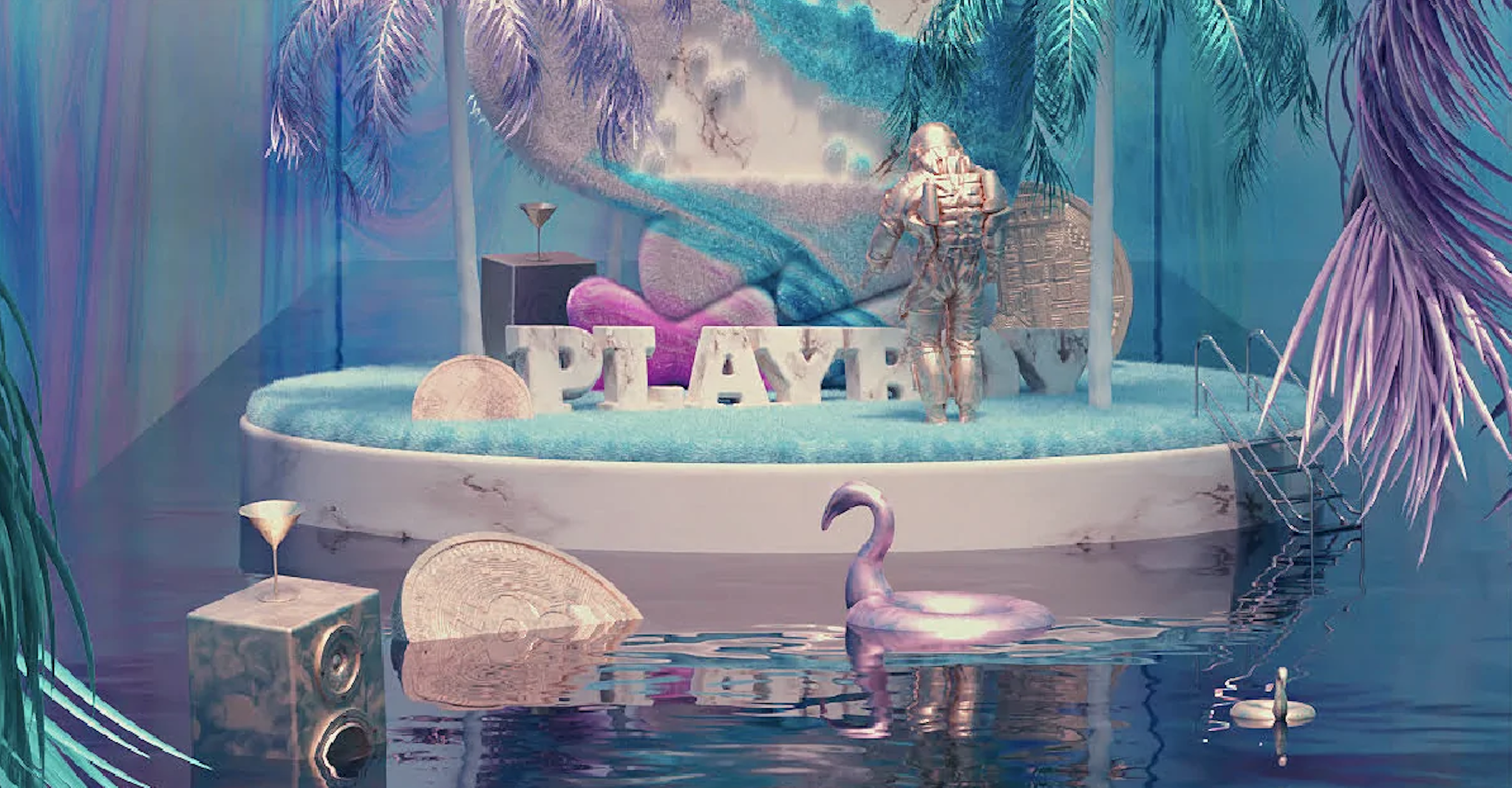09/07/2021 With Its Third NFT Art Drop, Playboy Exposes Full Crypto Commitment

Playboy is more than crypto-committed. Besides partnering on a number of non-fungible token digital art drops in the last few months, it’s set its sights on the broader goals of audience and revenue growth for the brand showing up in the digital world.
The lifestyle brand announced its third NFT digital art collaboration today, teaming up with NFT art marketplace SuperRare to showcase the Miami Beach Art Collection. The collection contains five original animated NFT artworks, spurred by—and including—an unearthed photo from 1970 featuring a Playboy Bunny water skiing outside of the Miami Playboy Club.
Miami also serves as the destination for the Bitcoin 2021 conference, where the collection was previewed in June to thousands of enthusiasts.
The Miami Beach Art Collection—including animated works by Ayla El-Moussa, REK0DE, Jon Noorlander and MBSJ—will go live virtually on the Ethereum-run virtual world Decentraland, where Playboy has designed a branded art gallery, following on from a partnership in May, in Decentraland’s Crypto Valley. As well as the art collection, the digital gallery will include the mainstays of any Miami space: a co-branded bar, palm trees, flamingoes, plus heritage Playboy covers and a set by U.S electronica DJ Verité. But art is just the beginning.
“The sky’s the limit in terms of artistic expression, new tech, and pairing that with tokens on the Blockchain,” chief brand and strategy officer Rachel Webber told Adweek.
NFTs are not a strategy
Brands and publishers have been playing with NFTs and crypto in the first half of this year with varying degrees of commitment. But limited use cases, unproven longevity and questions around sustainability have tempered some businesses’ appetite.
Since April, Playboy has been exploring digital art as a way to understand the community and introduce them to the Playboy brand. When it announced its first drop, its stock was up 83% for that month.
Since going public in October 2020 via the special purpose acquisition company route, it has transitioned away from a media company towards a lifestyle brand that sells products and services, underlined by its acquisition of lingerie company Honey Birdette for over $330 million in June. This ties into its new strategic pillars of fashion, sexual wellness, beauty and lifestyle (which includes gaming, art and hospitality).
“NFTs are not a strategy,” said Webber. “It’s about how we leverage new technology on the Blockchain in these immersive worlds to create the most innovative products and experiences that align with those categories.”
In terms of fashion more broadly, it’s already partnered with retailers and brands like Supreme, Comme des Garçons and jewelry brand The Great Frog. It also boasts tie-ups with artists like Slimesunday and Shantell Martin.
Playboy is now whitelisted on SuperRare, meaning it can continue releasing NFT drops with more regularity. In its first drop partnering with digital art auction hub Nifty Gateway, it generated $1 million in the first 24 hours. For its first tie-up with Decentraland in May,3,000 people spent time at the virtual gallery opening.
Art is just the beginning
Playboy has a history of supporting art collections and work from artists for decades, including Pablo Picasso, Salvador Dalí, Keith Haring, and Andy Warhol, making it well-positioned to capitalize on the boom in crypto-art.
“The tipping point that made mainstream media take notice [of NFTs] was the $69 million-sale piece of digital art,” Daniel Payne, a fin-tech lawyer at law firm Murphy & McGonigle, previously told Adweek. Fortunately thanks to more robust infrastructure and better use cases, “we’re in a place where NFTs and crypto have more staying power than in 2017.”
And new use cases keep cropping up. Beeple, the artist behind that $69 million piece of digital art in March, launched a new NFT platform Wenew several weeks ago auctioning off iconic moments in time, starting with sports. In June, CNN opened Vaults where people can buy NFTs of famous historical news moments.
Crypto goals in the digital world
Playboy is also about badge value, a kudos it wants to translate to the metaverse. In an investor presentation, Playboy said it drives $100 million of U.S. Gen Z audiences spend on Playboy streetwear. Globally, the Playboy brand drives $3 billion on annual spend of products in over 180 countries. In 2021, it’s forecast to generate over $200 million in revenue.
This commitment means investment and full company buy-in. Playboy’s NFT and Blockchain initiatives are led by its brand and new business development team. That also means it has created new roles like head of art and curation partnerships, filled by former magazine editorial director Liz Suman. Playboy has a team fully immersed in the worlds of Discord, Twitter, the metaverse and relationships with the NFT community.
That the overall volume of NFT transactions has waned since a high of $342 million in February is trifling. “We’re not even in the first inning,” said Webber. “We’re still in the dial-up era with how we employ Blockchain to consumer experiences. Community, utility and gamification are what makes something attract an audience and build for the long term.”
 (0)
(0)
 (0)
(0)
https://www.adweek.com/media/with-its-third-nft-art-drop-playboy-exposes-full-crypto-commitment/
